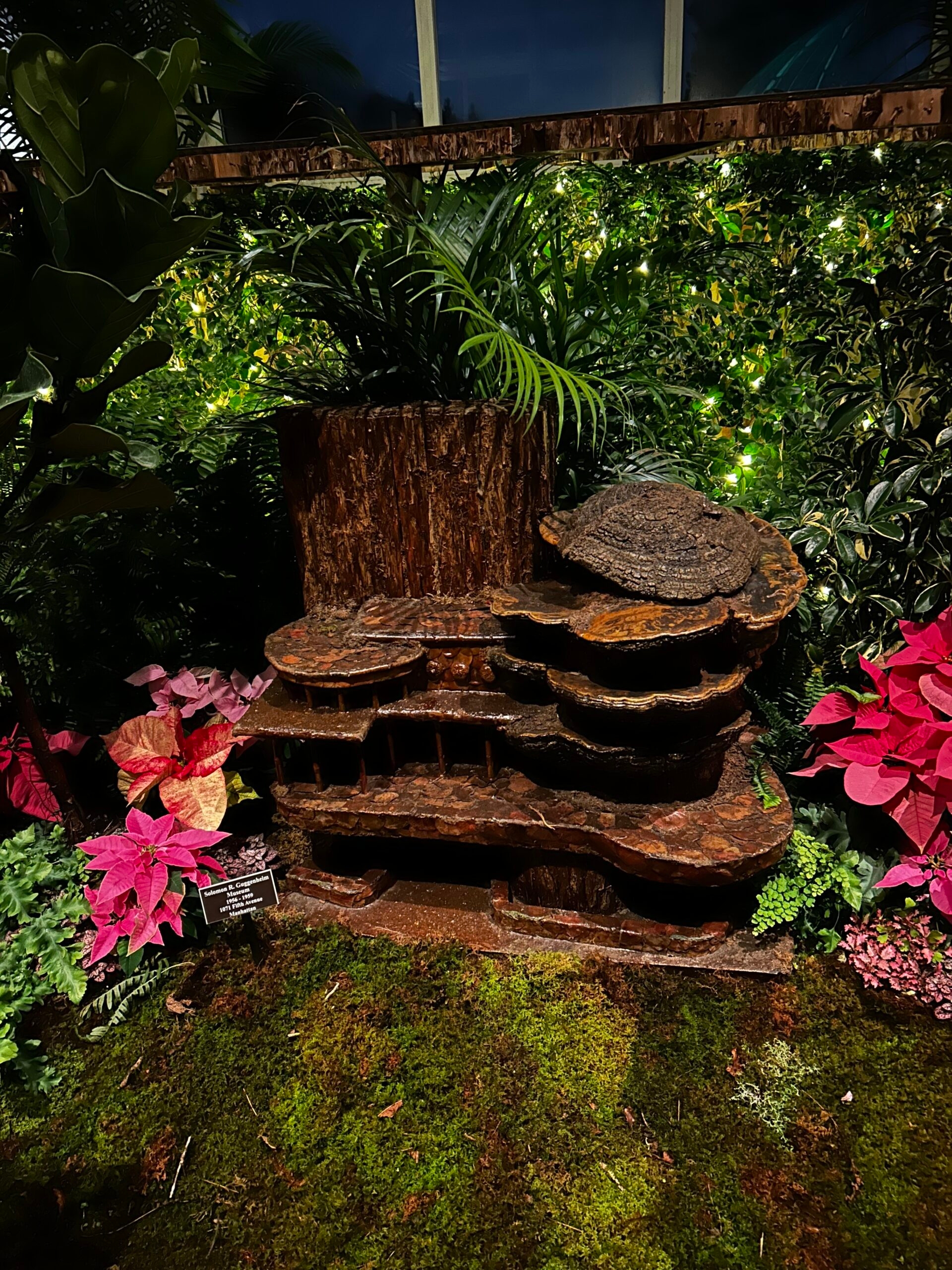Exploring the mind-boggling array of greenery at the New York Botanical Garden is always a bit of a magical experience. That’s even more true during the holiday season, when the Bronx garden’s Holiday Train Show makes its annual appearance, bringing a host of model trains that run through a miniature New York City erected inside the garden’s lush Enid A. Haupt Conservatory.
Each year since 1992, an ever-increasing number of New York landmarks — from City Hall to the Brooklyn Bridge to the Statue of Liberty and the Wonder Wheel at Coney Island — are featured in the show. The trains wend their way around more than 150 iconic New York sites — designed by Kentucky-based Applied Imagination art studio — which are all made out of real forest materials: tree bark, acorns, flowers, nuts, pine cones and the like.
“This is old world,” the garden’s president and chief executive Jennifer Bernstein told The New York Times. “This is a from-the-earth experience.”
I visited the train show recently and kept an eye out for the Jewish sites featured in the show, which runs through Jan. 20, 2025. Here are five of them.
1. Nathan Straus House, 1896
27 West 72nd St.

The Nathan Straus House, as seen at the New York Botanical Garden’s Holiday Train Show. (Gabe Friedman)
Even if you don’t know Nathan Straus’ name, you probably know the two department stores he co-owned, starting in the late 19th century: Abraham & Straus and R.H. Macy & Company (which now just goes by the far more familiar Macy’s). Straus’ Jewish family immigrated from present-day Germany to Georgia before the Civil War forced them to rebuild their lives up north, where the Straus family business launched by selling crockery to R.H. Macy & Company. (Macy’s completely took over the Abraham & Straus brand in the 1990s.)
Straus and his wife Lina were staunch early Zionists, visiting then-Palestine multiple times. His legacy continues there, as the Israeli city of Netanya is named after him.
For decades, Straus and his family lived in this house on West 72nd Street, that was built in 1896 and what has been described as a “brownstone mansion.” It was later turned into a condominium building.
2. The Jewish Museum (originally the Felix Warburg House), 1909
1109 Fifth Ave.

A model of the Jewish Museum, which was once the home of Felix Warburg and his family, is seen at the New York Botanical Garden. (Gabe Friedman)
The Jewish Museum, which has the largest collection of Jewish objects and artworks in the world outside of Israel, was originally a Châteauesque style mansion built for Jewish financier Felix Warburg. Warburg was very active in Jewish organizational life, heading for a time the 92nd Street Y (then the Young Men’s Hebrew Association) and helping lead the American Jewish Joint Distribution Committee in the wake of World War I.
The Jewish Museum moved into the space in 1947. You can by drop by IRL and check out the Tel Dan Stele, the oldest archeological evidence of King David (through Jan. 5); an exhibit by a Black artist and a Jewish artist that mocks the KKK (through March 30) or simply grab a bite at the new kosher cafe, Lox at the Jewish Museum.
3. The Solomon R. Guggenheim Museum, 1959
1071 Fifth Ave.

At the train show, the Guggenheim’s famous exterior is rendered with mushrooms, bark and more. (Gabe Friedman)
The Guggenheim, as it is commonly called, is one of the most famous museums in the world, known for its ringed Frank Lloyd Wright-designed building and for the groundbreaking art it houses. The museum’s founder, Solomon Guggenheim, was a wealthy Jewish mining magnate who became one of the world’s best-known modern art collectors, establishing a namesake foundation to preserve modern art in 1937. His niece Peggy Guggenheim built up her own impressive collection, which now lives in Venice as a museum and is one of the city’s most popular attractions.
The Guggenheim model at the train show is a standout, with its multi-color bark and mushroom facade.
4. Lillian and Amy Goldman Stone Mill, 1840
In the New York Botanical Garden, the Bronx

Lillian and Amy Goldman Stone Mill, recreated here inside the Enid A. Haupt Conservancy, became part of the New York Botanical Garden’s grounds in 1915. (Gabe Friedman)
This mill, founded as the Lorillard Snuff Mill, is the oldest standing tobacco mill building of its kind in the United States. Of course, it’s no longer a tobacco mill — it became part of the Botanical Garden grounds in 1915 and it now houses some offices and even a catering facility.
Lillian Goldman was one of the more prominent Jewish philanthropists in the country at the time of her death in 2002, with a net worth of close to $400 million, thanks to her late real estate investor husband Sol Goldman. Their daughter Amy is a well-known heirloom plant conservationist who has written several books on fruits and vegetables.
5. Naumburg Bandshell, 1923
Central Park

Central Park’s Naumburg Bandshell was the brainchild of Jewish banker and philanthropist Elkan Naumburg. (Gabe Friedman)
The Naumburg Bandshell, the only Neoclassical structure within Central Park, is the brainchild of merchant, banker and philanthropist Elkan Naumburg, who was born to a Jewish family in Bavaria and pioneered the idea of free classical music for all New Yorkers in 1905. The Naumburg Orchestral Concerts, “the world’s oldest continuous free outdoor classical concert series,” continue to this day.
The Holiday Train Show runs through Jan. 20, 2025, at the New York Botanical Gardens (2900 Southern Blvd., the Bronx). Click here for tickets and more information.
The New York Jewish Week brings you the stories behind the headlines, keeping you connected to Jewish life in New York. Help sustain the reporting you trust by donating today.





